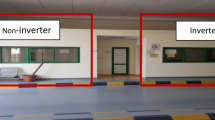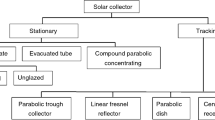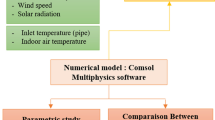Abstract
An overhead power line is a structure used in the electric power system to transmit electrical energy. The performance of overhead power lines depends on their parameters. An important parameter of the power line in the power system is its thermal limit. This article deals with the temperature calculation of overhead power line ACSR conductors according to the methodology stated in CIGRE Technical Brochure 601: Guide for thermal rating calculations of overhead lines. The calculated temperature is also compared with the measurement under laboratory conditions and also on a real power line in the Slovakia power system. At the end of the article, the dynamic thermal rating of ACSR conductors depending on climatic conditions is also calculated. Obtained results are compared with ampacity limits for summer and winter season used by Slovak transmission system operators. The article also compares the CIGRE Technical Brochure 601 with its older version CIGRE Technical Brochure 207: Thermal behavior of overhead conductors.
















Similar content being viewed by others
References
Beryozkina S, Sauhats A, Vanzovichs E (2011) Climate conditions impact on the permissible load current of the transmission line. In: Proceedings of the IEEE Trondheim PowerTech, pp 1–6
Yan Z, Wang Y, Liang L (2017) Analysis on ampacity of overhead transmission lines being operated. J Inf Process Syst 13:1358–1371
Šnajdr J, Sedláček J, Vostracký Z (2014) Application of a line ampacity model and its use in transmission lines operations. J Electr Eng 65:221–227
Kanálik M, Margitová A, Urbanský J, Beňa Ľ (2019) Temperature calculation of overhead power line conductors according to the CIGRE Technical Brochure 207. In: Proceedings of the 20th international scientific conference on electric power engineering (EPE), pp 24–28
Fernandez E, Albizu I, Bedialauneta M, Mazon A, Leite P (2016) Review of dynamic line rating systems for wind power integration. Renew Sustain Energy Rev 53:80–92
Teh J, Cotton I (2015) Critical span identification model for dynamic thermal rating system placement. IET Gener Transm Distrib 9(16):2644–2652
Musilek P, Heckenbergerova J, Bhuiyan M (2012) Spatial analysis of thermal aging of overhead transmission conductors. IEEE Trans Power Deliv 27(3):1196–1204
Quaia S (2018) Critical analysis of line loadability constraints. Int Trans Electr Energ Syst 24:1–11
Medveď D, Mišenčík L, Kolcun M, Zbojovský J, Pavlík M (2015) Measuring of magnetic field around power lines. In: Proceedings of the 8th international scientific symposium Elektroenergetika, pp 148–51
Heckenbergerova J, Musilek P, Filimonenkov K (2013) Quantification of gains and risks of static thermal rating based on typical meteorological year. Int J Electr Power Energy Syst 44(1):227–235
Heckenbergerova J, Musilek P, Filimonenkov K (2011) Assessment of seasonal static thermal ratings of overhead transmission conductors. In: Proceedings of the IEEE power and energy society general meeting, pp 1–8
Karimi S, Musilek P, Knight AM (2018) Dynamic thermal rating of transmission lines: a review. Renew Sustain Energy Rev 91:600–612
Arroyo A, Castro P, Martinez R et al (2015) Comparison between IEEE and CIGRE thermal behaviour standards and measured temperature on a 132-kV overhead power line. Energies 8(12):13660–13671
Fu J, Abbott S, Fox B, Morrow DJ, Abdelkader S (2010) Wind cooling effect on dynamic overhead line ratings. In: Proceedings of the 45th International Universities Power Engineering Conference (UPEC), pp 1–6
Abbott S, Abdelkader S, Bryans L, Flynn D (2010) Experimental validation and comparison of IEEE and CIGRE dynamic line models. In: Proceedings of the 45th International Universities Power Engineering Conference (UPEC), pp 1–5
Fu J, Morrow DJ, Abdelkader SM (2012) Integration of wind power into existing transmission network by dynamic overhead line rating. In: Proceedings of the 11th international workshop on large-scale integration of wind power into power systems, pp 1–5
Musavi M, Chamberlain D, Li Q (2011) Overhead conductor dynamic thermal rating measurement and prediction. In: Proceedings of the IEEE international conference on smart measurements of future grids (SMFG), pp 135–138
Kosec G, Maksić M, Djurica V (2017) Dynamic thermal rating of power lines—model and measurements in rainy conditions. Int J Electr Power Energy Syst 91:222–229
Pytlak P, Musilek P, Lozowski E, Toth J (2011) Modelling precipitation cooling of overhead conductors. Electric Power Syst Res 81:2147–2154
IEEE (2012) Standard for calculating the current-temperature relationship of bare overhead conductors. Std 738
CIGRE, Working Group 22.12 (2002) Thermal behaviour of overhead conductors, Technical Brochure 207
CIGRE, Working Group B2.43 (2014) Guide for thermal rating calculation of overhead lines, Technical Brochure 601
Schmidt N (1999) Comparison between IEEE and CIGRE ampacity standards. IEEE Trans Power Deliv 14:1555–1559
Michiorri A et al (2015) Forecasting for dynamic line rating. Renew Sustain Energy Rev 52:1713–1730
Simms M, Meegahapola L (2013) Comparative analysis of dynamic line rating models and feasibility to minimise energy losses in wind rich power networks. Energy Convers Manage 75:11–20
Liu G, Li Y, Liu S, Dong X, Qu F, Li Y (2016) Real-time solar radiation intensity modeling for dynamic rating of overhead transmission lines. In: Proceedings of the Australasian Universities Power Engineering Conference (AUPEC), pp 1–6
Ding Y, Gao M, Li Y et al (2016) The effect of calculated wind speed on the capacity of dynamic line rating. In: Proceedings of the IEEE international conference on high voltage engineering and application (ICHVE), pp 1–5
STN EN 50341-1: Overhead Electrical Lines Exceeding AC 45 kV. Part 1: General Requirements. Common Specifications (2013)
Acknowledgements
This work was supported by the Scientific Grant Agency of the Ministry of Education of Slovak Republic and the Slovak Academy of Sciences under the contract VEGA No. 1/0372/18.
Author information
Authors and Affiliations
Corresponding author
Ethics declarations
Conflicts of interest
The authors declare that they have no conflict of interest.
Additional information
Publisher's Note
Springer Nature remains neutral with regard to jurisdictional claims in published maps and institutional affiliations.
Rights and permissions
About this article
Cite this article
Kanálik, M., Margitová, A. & Beňa, Ľ. Temperature calculation of overhead power line conductors based on CIGRE Technical Brochure 601 in Slovakia. Electr Eng 101, 921–933 (2019). https://doi.org/10.1007/s00202-019-00831-8
Received:
Accepted:
Published:
Issue Date:
DOI: https://doi.org/10.1007/s00202-019-00831-8




